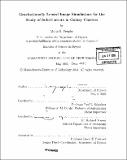Gravitationally lensed image simulations for the study of the substructure in galaxy clusters
Author(s)
Peeples, Molly S
DownloadFull printable version (2.577Mb)
Other Contributors
Massachusetts Institute of Technology. Dept. of Physics.
Advisor
Paul L. Schechter and Richard Massey.
Terms of use
Metadata
Show full item recordAbstract
As gravitational lensing is susceptible to all gravitating matter-both baryonic and dark-it provides a potentially clean way to study the mass distribution of galaxy clusters. We are particularly interested in the substructure of dark matter in galaxy clusters as it signals constraints on various cosmological parameters as well as cluster evolution. Gravitationally lensed image simulations are needed in order to determine just how much can be learned from current mass reconstruction methods. We present here a comprehensive procedure for generating such a set of simulated images using shapelets (Massey et al. (2005)). These images use a catalog of galaxies from the Hubble Space Telescope data taken as part of the Cosmos Evolution Survey (COSMOS). The background galaxies are then lensed by a 1015M galaxy cluster set at a redshift of z = 0.4. Noise and a point spread function (PSF) can also be added to the images; we chose to emulate the set of COSMOS pointings from the Subaru Telescope. As the shapelets simulation software allows complete freedom over all background galaxy, noise, and PSF parameters, the methods presented here have the potential to be used to not only verify that existing mass reconstruction algorithms work, but also to help optimize specifications on future telescopes. (cont.) We also present a preliminary strong lensing analysis of two noise- and PSF-free simulated images according to the algorithm presented in Diego et al. (2005). We found that while this procedure was able to accurately reproduce the surface mass density profile for radii greater than that of the outermost arcs used in the analysis, it failed in unexpected ways for the inner radii.
Description
Thesis (S.B.)--Massachusetts Institute of Technology, Dept. of Physics, 2005. Includes bibliographical references (p. 49-50).
Date issued
2005Department
Massachusetts Institute of Technology. Department of PhysicsPublisher
Massachusetts Institute of Technology
Keywords
Physics.